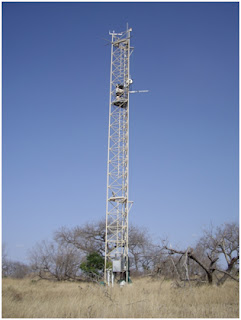Obtaining
estimates of Carbon emissions through the method of inverse modelling was not
something I had in mind for myself five years ago. I got into the CSIR with a
background in mathematical statistics and ecology. I had just finished a three
year lecturing position, which I did while completing my Masters in stats, at a
nearby university (attempting to teach statistics to first year biology
students – fun), and couldn’t wait to start my career in pure research. Best of
all, the group I was joining was a systems ecology group, and so I was going to
get to do work in both of my areas of interest.
I started
off with processing and modelling data from our Skukuza eddy-covariance flux
tower. The data collected here provides information on carbon dioxide and water
fluxes at a landscape level. This helps us to better understand processes like
primary productivity and ecosystem respiration, as well as evapotranspiration.
At the same time meteorological variables like air temperature, relative
humidity, wind speed and direction, and net radiation are measured, as well as
soil variables, like moisture and temperature. This helps us to understand what
the drivers are, and also to predict what will happen with ecosystem
productivity and respiration under different climate change scenarios.
 |
|
Skukuza Flux Tower – Kruger National Park
See http://www.instrumentalia.com.ar/pdf/Invernadero.pdf for more information on eddy
covariance methodology
|
I was minding
my own business one day in the office, doing fun and exciting things in R, when
my boss called me up and asked me if I was interested in instrumentation and
getting things to work. Looking back now, this was a turning point in my life.
If I knew then what I know now, I’m not so sure I would have answered yes. He
handed me an old broken PP Systems carbon dioxide gas analyser, specifically
for measuring soil fluxes, which looked to me like it had been built back in
the day of the first black and white TV, and basically told me to get it to
work. At university, when you’re studying statistics or ecology, nowhere are
you taught any electronics courses. That’s the sad reality of it. So I was
deeply overwhelmed, but fortunately got given the name of a very nice man who
was at the manufacturing unit, and was a whizz with a soldering iron, and he
helped me to figure out what the problem was. Really – he figured out what the
problem was and I watched. That was my first experience of getting down and
dirty with measuring carbon dioxide. The next thing I found myself attending a
summer school for flux measurements held at The University of Colorado Mountain
Research Station. I should have known it wasn’t just so that I could have fun
in Colorado.
It wasn’t
too long before I was asked to write a program for a datalogger to collect
information from a soil moisture probe. This basically entails having to
understand how the instrument works, and what instruction to give it to work,
and how to interpret the output of the instrument, which is usually voltage,
and turn it into a measurement. I’m always amazed every time I wire an
instrument up to a datalogger, and it starts giving out actual measurements. It
leaves one with a real sensation of satisfaction when the data all looks good.
On the other hand, when you wire up an instrument exactly the way the instructions
tell you to (or you think you have), and it gives out garbage, that’s an
entirely different sensation. Frustration, anger, resentment, disappointment,
despair, hopelessness …
 |
|
This may look like a mess of wires to you, but
each of those has its place and needs to correspond exactly to the program
written to collected the data
|
Before I
knew it, I was writing a program to get an entire flux tower and all its
meteorological instruments to operate. And not long after that, I was finding
myself in the field, attending to the every whim and desire of the instruments.
We have two flux towers in the Kruger National Park. When things are working,
life is great and the world is a happy place. But sometimes you can arrive on
site, and be inundated by every manner of problem that can befall an instrument.
Everything from elephants pushing a tree over onto the solar panel, ants
squatting in the instrumentation box and causing all sorts of shorts, or in
fact gecko’s taking up house – or scratch that – an entire ecosystem existing
in the instrumentation box. You’ll also be surprised how much damage the
African sun can do to instrument cables. Many of the instruments that we use
are shipped in from America or Europe, and having to deal with the kind of UV
we have down south here doesn’t always come into the equation. Don’t factor out
the wind and rain either. And then there’s human error, which is the kind which
causes me the most frustration and sleepless nights. I’m particularly good at
making those, and I’m always gobsmacked by how spectacularly wrong things can
go when just a tiny little detail is over looked.
 |
| Repositioning of the foliage by the local elephant hooligans |
Let me tell
you … working with instrumentation is not for the faint of heart.
No comments:
Post a Comment